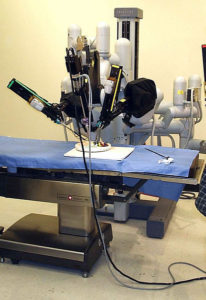Either part or all of the kidney is removed using robotic surgical technology.

What is it?
A robotic nephrectomy is a minimally invasive, robot-assisted surgery that removes all or part of the kidney in order to treat kidney cancer or to remove a damaged kidney. Damaged kidneys can be replaced with healthy, donor kidneys in a kidney transplant. A robotic nephrectomy differs from a traditional nephrectomy in that it uses an advanced robotic system controlled by the surgeon that results in less tissue trauma, smaller incisions, and improved visualization and surgical ability. The robotic system has arms with surgical instruments that are controlled by the surgeon in order to create more precise, controlled movements. Typically, patients experience less pain, faster recovery, less bleeding, minimal scarring, and shorter hospital stays with robotic versus traditional nephrectomies.
How to Prepare
If a patient is having a robotic nephrectomy, the patient should stop taking blood thinners, aspirin, and nonsteroidal anti-inflammatory medications for one week prior to the surgery. These medications can increase the risk of bleeding during the surgery, which can be a major complication. Patients should check with their physicians before ceasing medications because other medical problems may determine whether or not they should be stopped. The patient should discuss all of his or her current medications or supplements with the doctor in order to determine additional measures. The patient should drink a lot of water in the weeks prior to the surgery in order to keep the remaining kidney healthy. No food or drink should be taken starting from the midnight prior to the procedure in order to reduce the risk of aspiration, a rare but serious risk that occurs when the stomach’s contents enter the lungs during general anesthesia.
What happens during the procedure?
During a robotic nephrectomy, the patient is given general anesthesia, which are anesthetic drugs that put the patient to sleep for the duration of the procedure. After anesthesia is administered, the surgeon conducts the procedure entirely behind the robotic console. The surgeon controls the robotic arms and instruments while visualizing the surgery in high definition and real time on the screen that is part of the robotic machine. The video is projected from a small surgical camera that is inserted into one of the small incisions. The surgeon uses the robot to make small incisions through which the instruments are inserted. The incisions are made on the patient’s side where the kidney is, and the kidney is excised and removed. If it is a complete, radical nephrectomy, then the entire kidney is removed whereas a partial nephrectomy only removes the diseased/damaged portion of the kidney. If a donor kidney has been set up beforehand, the donor kidney is inserted and sutured into place.
Risks and Complications
Risks associated with a nephrectomy include high blood pressure, kidney disease, infection, bleeding, and risks associated with general anesthesia such as aspiration.
Disclaimer:
All GlobeHealer Site content, including graphics, images, logos, and text, among other materials on the site are for educational purposes only. This content is not intended to be a substitute for professional medical advice, and you should always contact your physician or qualified health provider for information regarding your health. Information on this site regarding the overview, diagnosis, and treatment of any kind should be looked at, in addition to the advice and information of your health care professional. Do not disregard medical advice or delay seeking treatment or medical advice due to information found on the GlobeHealer site.
If there is even the possibility that you may have a medical emergency, seek treatment, call your doctor, or call your local emergency telephone number immediately. GlobeHealer does not endorse being the first line of communication in case of emergency and does not endorse any specific test, physician, facility, product, procedure, opinion, or other information that is or may be mentioned on this site or affiliated entities. Reliance of any and all information provided by GlobeHealer, its employees, affiliations, others appearing on the Site under the invitation of GlobeHealer, or visitors of the site is solely at your own risk and is not the responsibility of GlobeHealer.
Image Source:
https://commons.wikimedia.org/wiki/File:Laproscopic_Surgery_Robot.jpg
